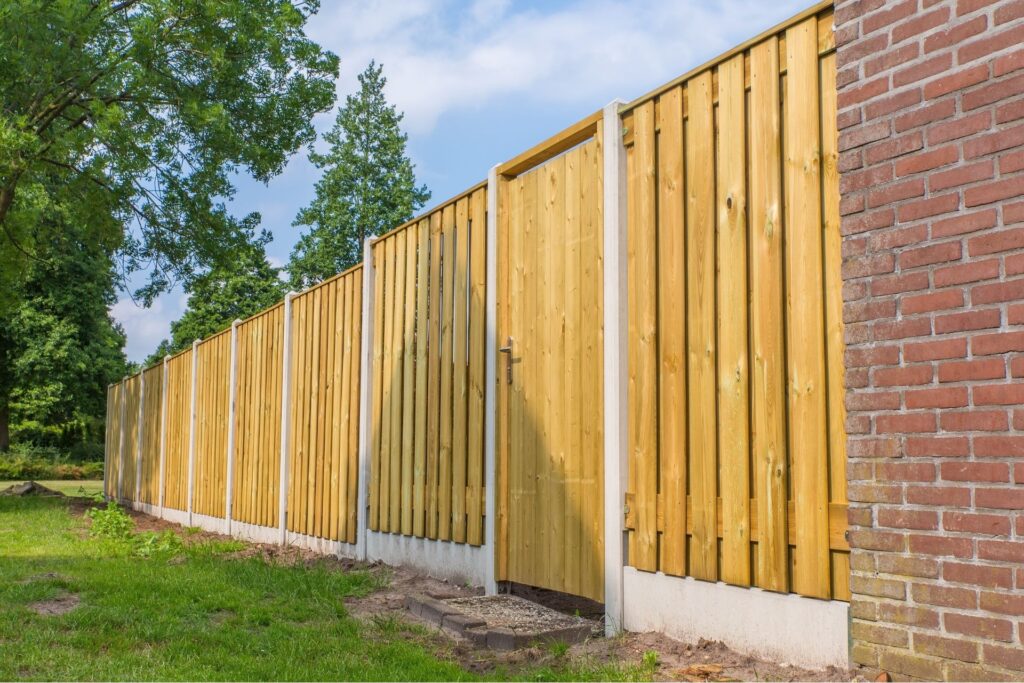Welcome to our comprehensive guide on navigating New Zealand’s Unitary Plan, specifically focusing on the height restrictions for fences. This plan plays a pivotal role in shaping the urban and suburban landscapes of our communities, and understanding its stipulations is crucial for homeowners, builders, and developers alike. In this article, we’ll delve into what the Unitary Plan is, why it includes specific guidelines for fences, and how these regulations affect you. Whether you’re planning to build a new fence or modify an existing one, this guide will provide you with all the necessary information to ensure your fencing project complies with local regulations, enhancing both the value and the aesthetic of your property.
Under New Zealand’s Unitary Plan, fence height restrictions vary by zone but generally, residential fences should not exceed 2.5 meters. This regulation ensures privacy, safety, and aesthetic harmony in communities. Special provisions may apply to corner lots or areas with special overlays. Compliance is crucial to avoid penalties and legal issues. For detailed guidelines and navigating the approval process, homeowners and developers should consult local council documents or seek professional advice.
Table of Contents
Overview Of The Unitary Plan
What is the Unitary Plan?
The Unitary Plan is a visionary blueprint designed to shape the future of urban environments. Its primary purpose is to provide a cohesive framework that governs land use and development within a specific area, ensuring that growth is both sustainable and strategically managed. This plan integrates various zoning regulations and policy stipulations into a single consolidated document, making it easier for city planners, developers, and residents to understand and follow the prescribed guidelines.
The genesis of the Unitary Plan can be traced back to the need for a streamlined, efficient approach to urban planning. As cities expand and populations increase, the challenge of managing urban spaces becomes more complex. The Unitary Plan was developed as a response to these challenges, aiming to replace piecemeal planning methods with a unified strategy that supports long-term growth and sustainability.
Goals and Objectives of the Plan
One of the core objectives of the Unitary Plan is to enhance urban design while respecting individual privacy and enhancing the aesthetic appeal of properties. The plan sets forth guidelines that influence the layout and appearance of buildings, the allocation of green spaces, and the overall density of developments. These regulations are intended to create a balanced, visually appealing urban landscape that promotes a high quality of life for its residents.
In terms of privacy, the Unitary Plan incorporates provisions that help maintain adequate spacing between buildings and regulate sightlines, ensuring that residents can enjoy their homes without feeling overlooked by neighbors or commercial entities. This thoughtful consideration in planning helps to uphold a sense of personal space and security, which is crucial in densely populated urban settings.
Importance of Fence Regulations
Fence regulations are a significant aspect of the Unitary Plan, underscoring the importance of defining boundaries while maintaining the aesthetic integrity of communities. These rules specify permissible heights and materials for fences to ensure they are not only functional but also contribute positively to the neighborhood’s appearance.
The rationale behind implementing height restrictions on fences is multifaceted: aesthetically, lower fences help preserve the open, airy character of neighborhoods and prevent the creation of fortress-like environments. From a privacy standpoint, these regulations strike a balance—providing enough coverage for residents to feel secure while avoiding the sense of seclusion that taller barriers might foster.
In summary, the Unitary Plan serves as a critical tool in urban management, guiding the development of cities in a way that is aesthetically pleasing, privacy-conscious, and conducive to sustainable growth. By adhering to its comprehensive guidelines, communities can thrive in an environment that values both individual and collective needs. Fence regulations, as a component of this plan, play a pivotal role in shaping the character and functionality of urban spaces, proving that even the smallest details can have a profound impact on the livability of our cities.

Understanding Fence Height Restrictions
When planning to erect a fence around your property, navigating the maze of local regulations regarding fence height is crucial. Whether you’re a first-time homeowner or a seasoned developer, understanding these rules can save you from legal hassles and extra costs. Here’s a detailed look at fence height restrictions to help you plan your project effectively.
General Rules for Fence Heights
Overview of Standard Height Restrictions
Most localities enforce specific height limits for fences to ensure safety, privacy, and aesthetic standards. Typically, residential fence heights are limited to about 6 feet in backyards and 4 feet in front yards. These limits can vary significantly based on local laws and neighborhood regulations, so it’s essential to check with your local building authority or homeowners’ association.
Explanation of Variations by Zones (Residential, Commercial, Rural)
The purpose of the zone in which your property is located can greatly influence the allowed fence height:
- Residential Zones: Aimed at maintaining privacy and aesthetics in a community setting, these areas often have stricter height restrictions.
- Commercial Zones: Here, security might be a higher priority, and fence heights could be allowed up to 8 feet or more.
- Rural Zones: With fewer nearby neighbors, rural properties might have more lenient height restrictions, allowing for taller fences to contain livestock or delineate property boundaries.
Special Provisions
Conditions Under Which Exceptions Are Allowed
While standard rules apply in most cases, there are exceptions that can allow for higher fences:
- Corner Lots: Due to visibility issues for passing traffic, corner lots might have specific height restrictions at the front. However, exceptions might be granted if safety is not compromised.
- Areas with Special Character Overlays: Historic districts or areas with unique aesthetic standards may have different rules to maintain a certain look or feel in the neighborhood.
Navigating these exceptions usually requires a variance or special approval from local governing bodies, so understanding the criteria and application process is crucial.
How These Restrictions Impact You
Practical Implications for Property Owners and Developers
Adhering to fence height restrictions is more than a legal requirement; it affects your property’s functionality and aesthetics. For homeowners, a fence that meets local regulations helps maintain good relationships with neighbors and protects the property’s resale value. Developers must be particularly diligent, as non-compliance can lead to project delays, fines, or required modifications.
Case Studies or Examples of Typical Scenarios
- Case Study 1: Residential Compliance: In a suburban neighborhood, a homeowner had to adjust the planned 6-foot backyard fence down to 4 feet based on local visual clearance regulations, significantly affecting their privacy landscaping plans.
- Case Study 2: Commercial Adjustment: A commercial property owner in a downtown area was allowed to increase the fence height from the standard 6 feet to 10 feet to enhance security for stored equipment, after obtaining a variance by demonstrating that the taller fence would not obstruct sightlines for nearby traffic.
Each case study underscores the importance of understanding local regulations and seeking appropriate approvals before construction begins.
By keeping these points in mind and consulting with local authorities or a legal advisor, you can ensure that your fencing project adheres to all applicable laws and serves its intended purpose effectively.

Compliance And Consequences
When undertaking any construction or modification to property structures such as fencing, understanding and adhering to local regulations is crucial. Section 3 of our guide delves into the importance of compliance with the Unitary Plan standards and outlines the consequences should these standards not be met. This section is essential for homeowners and contractors alike, ensuring that all fencing projects are up to code, thus avoiding legal pitfalls and ensuring neighborhood harmony.
Ensuring Compliance
Compliance with the Unitary Plan standards isn’t just about following rules—it’s about ensuring that the fencing projects enhance safety, aesthetics, and community values. Here’s how you can ensure your fence meets these standards:
1. Understanding Unitary Plan Standards: Before starting your project, familiarize yourself with the local Unitary Plan standards. These standards may dictate the height, materials, and placement of your fence, ensuring it is in harmony with the community’s guidelines.
2. Obtaining Necessary Permits and Documentation: Almost all fencing projects will require some form of permit or documentation to ensure everything is up to code. Contact your local council or governing body to apply for these permits. Be prepared to submit detailed plans of the proposed fence, including measurements and materials used, as part of your application. Keeping copies of all documents submitted and received is crucial for your records.
By taking these steps, you can prevent delays, avoid penalties, and ensure that your fencing project progresses smoothly and legally.
Consequences of Non-Compliance
Failing to comply with the necessary standards can lead to several issues, ranging from financial penalties to legal disputes. Understanding these consequences can motivate compliance and ensure more responsible fencing practices:
1. Penalties and the Process of Rectification: Non-compliance can lead to fines determined by the severity of the deviation from the Unitary Plan. If found non-compliant, you may be required to modify or completely remove your fence at your own expense. It’s vital to address any notified issues promptly to avoid escalating penalties.
2. Handling Disputes Through Mediation and Legal Proceedings: Disputes may arise if a neighbor or the council deems your fence non-compliant. Typically, the first step is mediation, where both parties can come to an amicable agreement. If mediation fails, legal proceedings may follow, where a court will determine the necessary actions you must take and any further penalties.
Compliance is not just about avoiding penalties but about respecting the community’s standards and contributing to a well-regulated environment. By adhering to the rules, homeowners and builders can avoid the stress of legal challenges and enjoy a peaceful residential life.
Understanding the intricacies of compliance and the potential consequences of non-compliance ensures that you undertake fencing projects with due diligence and responsibility. This approach not only fosters good neighborly relations but also upholds the integrity and safety of the community.

Navigating Challenges And Seeking Approval
When embarking on a land development project, two critical areas often determine the success and fluidity of your progress: navigating the regulatory challenges and effectively seeking the necessary approvals. Below, we delve into each aspect, offering practical advice and a detailed guide to assist you in moving forward without unnecessary hiccups.
Challenges in Compliance
Compliance issues can present significant roadblocks in your land development journey. Understanding common problems and how to sidestep them is crucial.
Common Issues and Avoidance Strategies
One of the frequent challenges in land development involves adhering to zoning laws and building codes, which vary significantly from one jurisdiction to another. Common pitfalls include non-compliance with environmental regulations, underestimating utility requirements, and ignoring local building codes, each of which can delay your project or lead to hefty fines.
To avoid these issues
- Research thoroughly: Before you plan, invest time in understanding all local regulations pertinent to your land. This step is foundational and should guide your entire project’s planning phase.
- Engage with authorities early: By discussing your plans with local officials early on, you can gain insights into specific compliance challenges you may face and how to address them efficiently.
- Regular compliance checks: As your project progresses, regularly check that you are in compliance with all local, state, and federal regulations. It’s easier to adjust course mid-project than to face compliance issues later.
Tips for Dealing with Sloped Lands or Irregular Property Lines
Working with sloped lands or irregular property lines can be technically challenging due to the difficulties in construction and the potential for increased environmental impact.
- Conduct a detailed land survey: Before any planning, have a professional survey conducted. This will give you precise information about the topography and boundaries of your property.
- Consult with an engineer: Especially for sloped lands, a civil or structural engineer can provide design options that minimize land disruption and meet regulatory standards.
- Consider innovative design solutions: Sometimes, unconventional or innovative designs are necessary to make the best use of irregular landscapes while staying compliant with zoning laws.
Process for Seeking Approval
Securing the necessary approvals can be as daunting as navigating compliance, but a systematic approach can streamline the process.
Step-by-Step Guide to Obtaining Necessary Approvals
1. Initial Research: Start by gathering all relevant information about zoning, environmental, and building code requirements specific to your area.
2. Pre-application meeting: Arrange a meeting with local planning officers. This can provide valuable insights into the likely challenges and approval pathways for your project.
3. Formal Application Submission: Prepare your application, ensuring all documentation is complete and accurate. Incomplete applications are a common reason for delays.
4. Respond to Queries and Requests: Be responsive to any queries from the planning department. Providing additional information promptly can help keep your project moving forward.
5. Public Consultation (if required): Some projects require public consultation. Be prepared to present your project to the community and address any concerns they might have.
Contacting Local Councils and Consulting with Experts
- Local Councils: Your local council is your primary resource for approval processes. Contact them early and often for advice and to understand all local requirements and timelines.
- Consulting with Experts: Experts, such as urban planners, environmental consultants, and legal advisors, can provide the expertise needed to navigate complex regulatory environments and improve the likelihood of obtaining approvals.
By thoroughly understanding and preparing for the challenges in compliance and the steps involved in seeking approvals, you can significantly enhance the efficiency and success of your land development projects. Effective planning and proactive engagement with all stakeholders not only streamline the approval process but also help in building a robust foundation for your development initiative.

Additional Resources And Expert Advice
Navigating the complexities of construction or renovation projects often requires more than just a solid plan and the right tools; it also demands the expertise of seasoned professionals. This section is dedicated to guiding you through the process of consulting with professionals and leveraging the best resources and tools to ensure your project’s success.
Consulting with Professionals
When and Why to Consult with an Architect or a Planner
Embarking on a building project, whether it’s a home extension, a new commercial development, or a renovation, involves a series of critical decisions that can significantly affect the project’s outcome. Consulting with an architect or a planner is crucial under several circumstances:
1. Compliance with Regulations: Architects and planners are well-versed in the local building regulations and codes. Their expertise ensures that your project adheres to all legal requirements, avoiding costly and time-consuming corrections later.
2. Optimizing Functionality and Aesthetics: These professionals help in maximizing the use of space while maintaining aesthetic appeal, which can considerably increase the value of the property.
3. Problem Solving: They offer creative solutions to complex problems, which can be anything from dealing with a difficult site layout to selecting sustainable materials and technologies.
4. Project Management: Experienced architects and planners can oversee the project from conception through completion, ensuring that the project stays on schedule, within budget, and is executed according to plan.
List of Resources for Finding Qualified Professionals in NZ
Finding the right professional is pivotal to the success of your project. Here are some resources to help you locate qualified architects and planners in New Zealand:
- New Zealand Institute of Architects (NZIA): This professional body provides a directory of registered architects who adhere to professional standards.
Planning Institute New Zealand (PINZ): PINZ offers a comprehensive list of planning professionals specialized in various aspects of construction and urban planning.
- Local Council Websites: Most local council websites have links to approved contractors and consultants who are familiar with regional regulations and requirements.
Online Reviews and Forums: Websites like NoCowboys.co.nz and Builderscrack.co.nz allow users to review and recommend professionals, giving you insights from other customers’ experiences.
Useful Resources and Tools
Links to Official Unitary Plan Documents and Zoning Maps
Understanding the zoning regulations and the Unitary Plan is crucial for anyone involved in property development or renovation in New Zealand. Here are some valuable resources:
- Auckland Council’s GeoMaps: This interactive tool provides detailed information about zoning, property boundaries, and topographical data essential for planning purposes.
- Unitary Plan Document Library: The Auckland Council maintains a comprehensive library of Unitary Plan documents, which are indispensable for understanding the regulations governing land use and development in the area.
Tools for Measuring and Planning Fence Placement
Proper fence placement is critical to avoid disputes and ensure compliance with local codes. Here are some tools that can help:
- Online Measuring Tools: Websites like Google Earth and apps like Measure Map can be used to accurately measure land boundaries and plan fence lines.
- Fence Planning Software: Tools like SketchUp and Home Designer Software allow you to visualize fence placement in 3D, helping to better integrate the new structures with existing ones.
By utilizing these resources and consulting with the right professionals, you can significantly enhance the efficiency and outcome of your building projects.

FAQs: About NZ’s Unitary Plan Height Restrictions For Fences
What is the Unitary Plan?
The Unitary Plan is Auckland’s rulebook that outlines regulations for urban development, including rules for building and modifying structures like fences. It determines how land can be used and developed to support population growth and infrastructure.
How high can a fence be under the Unitary Plan?
Generally, in residential zones, the maximum height for a fence is 2.5 meters. However, this can vary depending on the specific zone and any applicable overlays or exceptions.
Are there different height restrictions for front and backyard fences?
Yes, often the height restrictions for front yard fences are lower to maintain street visibility and aesthetic, while backyard fences may be permitted to be taller for increased privacy.
Can I apply for an exemption if I want a taller fence?
Yes, property owners can apply for a resource consent to build a fence higher than the regulated height. Approval depends on factors like the impact on neighbors and the overall community.
What are the consequences of building a fence that violates the height restrictions?
Building a fence that exceeds height restrictions without proper consent can lead to penalties such as fines and may require the fence to be altered or removed to comply with the regulations.
How do I ensure my fence plan complies with the Unitary Plan?
Before building, check the specific rules for your zone in the Unitary Plan, consult with your local council, and consider hiring a planning professional to ensure compliance.
What should I do if my existing fence doesn’t comply with the Unitary Plan?
You may need to apply for a retrospective resource consent or alter the fence to meet the required standards. Consulting with the council can provide guidance on the best course of action.
Are there any resources available to help understand fence height regulations?
Local council websites offer resources like zoning maps and the full text of the Unitary Plan. Planning consultants and legal advisors can also provide assistance.
How do fence height restrictions impact neighborhood aesthetics?
Height restrictions are designed to maintain a harmonious and open neighborhood aesthetic, ensuring that fences do not obstruct views or create a feeling of confinement within the community.
Where can I find more detailed information about applying for a resource consent for a fence?
Detailed information can be obtained from your local council’s website or by contacting their planning department directly. They can provide guidance on the application process and any documentation needed.
Conclusion
Understanding and adhering to the Unitary Plan’s height restrictions for fences is crucial, not only for legal compliance but also for enhancing the value and aesthetics of your property. By proactively planning and ensuring that your fencing projects align with these guidelines, you contribute to maintaining high community standards and ensuring harmony in your neighborhood’s appearance. Before embarking on any fencing project, it’s wise to consult with a professional who can offer tailored advice and ensure that your plans meet all local requirements. Additionally, staying informed about updates to local regulations can save you from potential legal hassles. Consider subscribing to updates on local regulations or directly contacting local authorities for any personal inquiries to keep yourself well-informed and prepared.
About the Author:
Mike Veail is a recognized digital marketing expert with over 6 years of experience in helping tradespeople and small businesses thrive online. A former quantity surveyor, Mike combines deep industry knowledge with hands-on expertise in SEO and Google Ads. His marketing strategies are tailored to the specific needs of the trades sector, helping businesses increase visibility and generate more leads through proven, ethical methods.
Mike has successfully partnered with numerous companies, establishing a track record of delivering measurable results. His work has been featured across various platforms that showcase his expertise in lead generation and online marketing for the trades sector.
Learn more about Mike's experience and services at https://theleadguy.online or follow him on social media:










